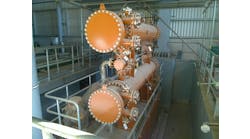Last month, “Keep Your Cool In Hot Weather,” dealt with performance testing of cooling towers, but determining why a tower isn’t working well may require entering it. Knowing what hazards are present in and around towers will allow for safe entry and inspection.
A number of hazards can exist in a tower. The first is physical: tower components may deteriorate due to erosion and biological and chemical attack. This can lead to structural defects that may weaken struts or ties that can fail when weight is applied. Whole towers have been known to collapse. Fans have fallen into towers. Loosened blades have been ejected through the fan shroud. Check the tower history before entry.
[pullquote]
Biological and chemical attacks may create additional hazards. Moss and other algae may be present during your inspection. Exposure to Legionella is just one of many risks. Personal protective equipment (PPE) is necessary to minimize such threats. Process leaks may leave chemical residue in the tower. Check with area personnel; they may have special entry procedures based on hazards reviews.
Finally, cooling towers are fairly good dust filters. Mud can accumulate in numerous locations, including distribution headers, tower basins and film fill. These can create slipping hazards as well as weight distributions that may weaken a tower.
A Lesson From Jake
Early in Jake’s career, he was asked to carry out a cooling tower test and follow up inspection. His mentor assured Jake he was ready; he provided Jake his best guidance and a reading list of cooling tower articles on redwood properties and the potential attack mechanisms. Jake felt prepared but felt a little trepidation about his first solo test and inspection.
The synthesis area had two cooling towers; one was a relatively new single-sided crossflow tower and the other an old counterflow tower that had been kept in service by carefully inspecting and renewing damaged parts. Both towers had nearly identical design capacities. He reviewed the operating history. He sat down with the operators to get their input. They told him the old tower performed best. In addition, there was a history of process chemical leaks in the cooling tower water stream.
Jake and the area engineer tested the two towers over the next two days and found the old tower missed design by 10°F. Jake noted that the flow patterns indicated a problem with the old tower.
The next day, the two began inspecting the crossflow tower. They wore protective goggles and dust masks. Because the tower was small, they could complete the inspection using a short ladder to reach the components. As Jake climbed into the tower, he grasped one of the struts and his fingers sunk into the strut’s interior, suggesting internal attack. Using a ball peen hammer, he pinged various structural elements, listening for a solid thud. Using an awl, he probed the areas that didn’t have a solid sound. Jake observed several areas near the top of the tower where the wooden fill bars appeared very grainy, indicating a loss of the tannin or soft part of the wood due to chemical attack. Near the bottom of the tower he noted sagging fill, signifying an attack on the lignin. On one piece of the lower fill that was not sagging he broke a section in two with nearly a square break, which indicated most of the lignin was gone in that piece. A maintenance order was scheduled for the fall.
Inspecting the second tower required a lot more pre-work. They removed a piece of fan deck to gain access to the upper reaches of the fill section. This inspection required additional PPE because it was classified as a vessel entry. Based on the pattern of falling water, Jake suspected some sort of water maldistribution. The main and lateral wooden channels were full of mud. Water from the main inlet header dumped into the main channel and then diverted up and over the edge falling in a column to the basin. The fill was in good shape. Once the inspection was completed, the plant used fire hoses to wash out the distribution channels and return the tower to service. With the distribution problem corrected, tower performance returned to design.
With summer approaching, this is a great time to check tower internals to prevent unknown issues from reducing cooling capacity and thereby curtailing plant production.
Active in both, the American Society of Mechanical Engineers and the American Society of Heating, Ventilating, Refrigerating, and Air-Conditioning Engineers (ASHRAE), Clark was chairman of ASHRAE's task group on Halocarbon Emissions and served on the committee that created ASHRAE SPG3 - Guideline for Reducing Halocarbon Emissions. He has written numerous papers on CFC alternatives and retrofitting CFC chillers. He was awarded a U.S. patent on a method for reducing emissions from refrigeration equipment. He has served as technical resource for several others.
You can email him at [email protected]


